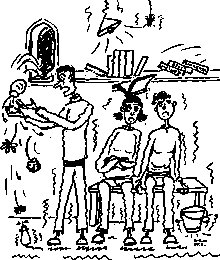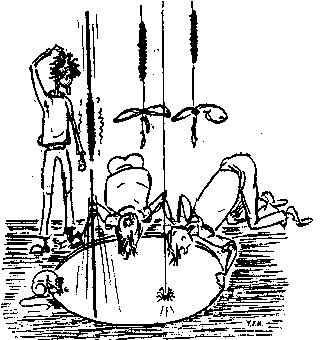The Tower Handbook
5.6 Towers
a: What would be an ideal tower acoustically?
A well-known bell-founder once said that an ideal tower would have no bell chamber windows and no roof. This is clearly not practical, but does make the point that the sound of bells should be allowed to go upwards and mixed to produce a balanced effect before issuing from the tower. Some of the most acoustically successful bell installations have a very tall bell chamber with windows well above the level of the bells. Bell chambers with window sills below the mouths of the bells (when up) tend to produce sound that is relatively loud in the immediate vicinity, with the bells nearest the window dominating the effect on each side.
b: Why do some towers shake?
 A swinging bell exerts large forces, both vertically and horizontally on the frame. The forces vary during each swing. The vertical force is greatest (four times the weight) as the bell swings through the mouth down position. The horizontal force pushes first one way and then the other. It is greatest (twice the weight) as the bell swings through the horizontal on each side.
A swinging bell exerts large forces, both vertically and horizontally on the frame. The forces vary during each swing. The vertical force is greatest (four times the weight) as the bell swings through the mouth down position. The horizontal force pushes first one way and then the other. It is greatest (twice the weight) as the bell swings through the horizontal on each side.
These forces are all transmitted to the tower which is much heavier, so it can easily withstand them, but like all structures it moves a little in response.
In most towers this is so small you may not notice it, but in some towers several factors combine to make it much larger.
- Tall slender towers with heavy bells high up will move more. Moving the bells a relatively small distance lower can significantly reduce the amount of movement.
- Brick is more elastic than stone so brick towers tend to sway more.
- Resonance is a less obvious factor. If the period with which the bells swing is a multiple of the natural period with which the tower can sway, then the tower resonates and the movement builds up to be many times more than it would otherwise be.
To put things in perspective, bear in mind that the forces produced by bells ringing are about the same size as those imposed on a tower by a fairly strong wind. A fuller description is given in A Practical Analysis of the Interaction between Church Bells and Towers.
c: Why does tower movement come and go during the ringing?
Each bell generates forces as it swings (see above). With all the bells swinging, these pulsating forces combine to produce an overall force on the tower. This combined force will be bigger or smaller depending on whether the forces of individual bells tend to reinforce (when swinging the same way) or cancel each other out (when swinging opposite ways). This depends on the relative timing of the forces from different bells. As the order of the bells changes, the combined force will therefore get larger or smaller. See the above reference.
d: Why do spiral staircases usually turn to the right going up?
In mediaeval castles, spiral staircases were built to give the advantage to the defender. A right-handed swordsman facing down the staircase could use his sword much more easily than one coming up. Presumably the craftsmen who built castles were the same as those who built churches, which is why many staircases in churches go the same way.
e: What is the best location for the ringing room?
 For most of us most of the time, this is irrelevant because it is fixed. The picture shows a typical tower with upstairs ringing chamber. If you are ever in the position to contemplate this you may consider:
For most of us most of the time, this is irrelevant because it is fixed. The picture shows a typical tower with upstairs ringing chamber. If you are ever in the position to contemplate this you may consider:
Pro upstairs
- Shorter draughts giving easier bell handling.
- Less likely to be used as store room, vestry, etc. [37]
Pro downstairs
- No stairs to climb for ringing.
Pro open to the church
- Ringers are seen by the congregation and more part of the body of the church.
- 'Free' warmth for service ringing.
Pro closed from the church
- Avoid conflict with organ playing.
- Easier to heat if cold.
f: How did they get the bells into the tower?
 Looking at the bells in the bell chamber, you may think it would be impossible to get them into or out of the tower since they would never fit going down the stairs. They are normally lifted up the tower through a series of large trap doors (so the bell whose pit is over the trap door had to be put in place last).
Looking at the bells in the bell chamber, you may think it would be impossible to get them into or out of the tower since they would never fit going down the stairs. They are normally lifted up the tower through a series of large trap doors (so the bell whose pit is over the trap door had to be put in place last).
There may be a trap door underneath the ringing chamber carpet. If someone has installed a floor, an organ, a clock or a heating unit in the tower, it may block the route if you ever needed to get the bells out. Some towers have had to take drastic measures and remove the louvres or remove the roof and lift the bells out by crane.
Previous

 Next
Next
Currently hosted on jaharrison.me.uk
 A swinging bell exerts large forces, both vertically and horizontally on the frame. The forces vary during each swing. The vertical force is greatest (four times the weight) as the bell swings through the mouth down position. The horizontal force pushes first one way and then the other. It is greatest (twice the weight) as the bell swings through the horizontal on each side.
A swinging bell exerts large forces, both vertically and horizontally on the frame. The forces vary during each swing. The vertical force is greatest (four times the weight) as the bell swings through the mouth down position. The horizontal force pushes first one way and then the other. It is greatest (twice the weight) as the bell swings through the horizontal on each side. For most of us most of the time, this is irrelevant because it is fixed. The picture shows a typical tower with upstairs ringing chamber. If you are ever in the position to contemplate this you may consider:
For most of us most of the time, this is irrelevant because it is fixed. The picture shows a typical tower with upstairs ringing chamber. If you are ever in the position to contemplate this you may consider: Looking at the bells in the bell chamber, you may think it would be impossible to get them into or out of the tower since they would never fit going down the stairs. They are normally lifted up the tower through a series of large trap doors (so the bell whose pit is over the trap door had to be put in place last).
Looking at the bells in the bell chamber, you may think it would be impossible to get them into or out of the tower since they would never fit going down the stairs. They are normally lifted up the tower through a series of large trap doors (so the bell whose pit is over the trap door had to be put in place last).